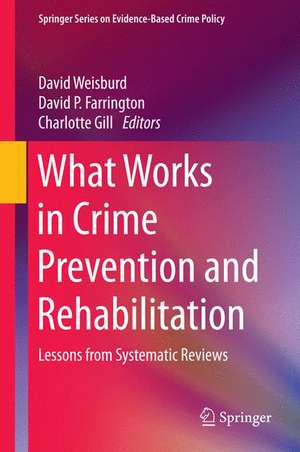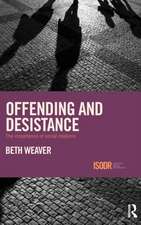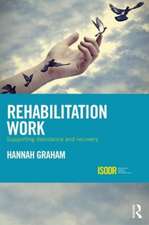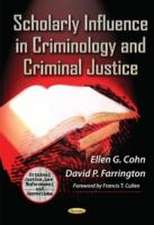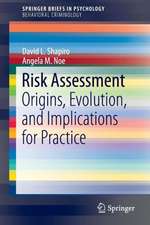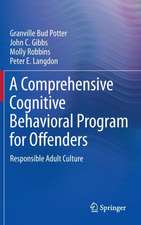What Works in Crime Prevention and Rehabilitation: Lessons from Systematic Reviews: Springer Series on Evidence-Based Crime Policy
Editat de David Weisburd, David P. Farrington, Charlotte Gillen Limba Engleză Hardback – 15 apr 2016
Systematic reviews aim to minimize any possible bias in drawing conclusions by stating explicit criteria for inclusion and exclusion of studies, by conducting extensive and wide-ranging searches for possibly eligible studies, and by making all stages of the review explicit and transparent so that the methods can be checked and replicated. Over a decade ago, a concerted effort was made by members of the criminology community, including the Editors and contributors of this volume, to bring the practice of systematic reviews to the study of Criminology, providing replicable, evidence-based data to answer key questions about the study of crime causation, detection, and prevention. Now, the pioneers in this effort present a comprehensive stock-taking of what has been learned in the past decade of systematic reviews in criminology. Much has been discovered about the effectiveness of (for example) boot camps, “hot spots” policing, closed-circuit television surveillance, neighborhood watch, anti-bullying programs in schools, early parenting programs, drug treatment programs, and other key topics.
This volume will be of interest to researchers in criminology and criminal justice, as well as in related fields such as public health and forensic science, with important implications for policy-makers and practitioners.
Decisively showing that the “nothing works” era is over, this volume takes stock of what we know, and still need to know, to prevent crime. I plan to keep this book close at hand and to use it often!
Francis T. Cullen, Distinguished Research Professor Emeritus,
University of Cincinnati At a time when there is a broad commitment to bringing science to the front lines of practice, this book should be on the reading list of both policymakers and scholars.Laurie O. Robinson, Clarence J. Robinson Professor of Criminology, Law Society, George Mason University and former Assistant Attorney General of the U.S. Department of Justice
| Toate formatele și edițiile | Preț | Express |
|---|---|---|
| Paperback (1) | 729.36 lei 6-8 săpt. | |
| Springer – 11 oct 2017 | 729.36 lei 6-8 săpt. | |
| Hardback (1) | 1007.65 lei 6-8 săpt. | |
| Springer – 15 apr 2016 | 1007.65 lei 6-8 săpt. |
Preț: 1007.65 lei
Preț vechi: 1228.85 lei
-18% Nou
Puncte Express: 1511
Preț estimativ în valută:
192.84€ • 209.39$ • 161.98£
192.84€ • 209.39$ • 161.98£
Carte tipărită la comandă
Livrare economică 22 aprilie-06 mai
Preluare comenzi: 021 569.72.76
Specificații
ISBN-13: 9781493934751
ISBN-10: 1493934759
Pagini: 331
Ilustrații: XII, 331 p. 18 illus., 6 illus. in color.
Dimensiuni: 155 x 235 x 21 mm
Greutate: 0.67 kg
Ediția:1st ed. 2016
Editura: Springer
Colecția Springer
Seria Springer Series on Evidence-Based Crime Policy
Locul publicării:New York, NY, United States
ISBN-10: 1493934759
Pagini: 331
Ilustrații: XII, 331 p. 18 illus., 6 illus. in color.
Dimensiuni: 155 x 235 x 21 mm
Greutate: 0.67 kg
Ediția:1st ed. 2016
Editura: Springer
Colecția Springer
Seria Springer Series on Evidence-Based Crime Policy
Locul publicării:New York, NY, United States
Public țintă
ResearchCuprins
Chapter 1: Introduction: What Works in Crime Prevention? David Weisburd, David P. Farrington, and Charlotte Gill.- Chapter 2: Developmental and social prevention David P. Farrington, Friedrich Losel and Maria M. Ttofi.- Chapter 3: Community interventions Charlotte Gill.- Chapter 4: Situational prevention Kate J. Bowers and Shane D. Johnson.- Chapter 5: Policing Cody W. Telep and David Weisburd.- Chapter 6: Sentencing and deterrence Amanda E. Perry.- Chapter 7: Correctional programs David B. Wilson.- Chapter 8: Drug interventions Katy R. Holloway and Trevor H. Bennett.- Chapter 9: Qualitative data in systematic reviews Mimi Ajzenstadt.- Chapter 10: Evidence mapping to advance justice practice Michael S. Caudy, Faye S. Taxman, Lienshang Tang and Carolyn Watson.- Chapter 11: Economic analyses Jacqueline Mallender and Rory Tierney.- Chapter 12: Conclusion: What Works in Crime Prevention Revisited David Weisburd, David P. Farrington, and Charlotte Gill.
Recenzii
“What Works in Crime Prevention and Rehabilitation: Lessons From Systematic Reviews, a volume in the Springer series on evidence-based crime policy, is a timely collection of 12 compendious chapters written by leading scholar … . Weisburd et al. is currently the best sourcebook of “big data” on correctional programs and would appeal to varied audiences, such as criminal justice policymakers and practitioners; crime prevention researchers and scholars; and advanced undergraduate and graduate students in criminology courses.” (Arthur J. Lurigio, PsycCRITIQUES,Vol, 61 (40), October, 2016)
Notă biografică
David Weisburd is Distinguished Professor of Criminology, Law and Society at George Mason University and Executive Director of the Center for Evidence-Based Crime Policy. He is also the Walter E. Meyer Professor of Law and Criminal Justice at the Hebrew University in Jerusalem and Chief Science Adviser at the Police Foundation in Washington DC. Professor He is the 2010 recipient of the Stockholm Prize in Criminology and received the Sutherland Award for contributions to criminology from the American Society of Criminology in 2014. In 2014 he also received he Robert Boruch Award for distinctive contributions to research that influences public policy of the Campbell Collaboration.
David P. Farrington is Emeritus Professor of Psychological Criminology in the Institute of Criminology, Cambridge University. He received the Stockholm Prize in Criminology in 2013. He is Chair of the American Society of Criminology Division of Developmental and Life-Course Criminology.
His major research interest is in developmental criminology, and he is Director of the Cambridge Study in Delinquent Development, a prospective longitudinal survey of over 400 London males from age 8 to age 56. In addition to over 650 published journal articles and book chapters on criminological and psychological topics, he has published nearly 100 books, monographs and government reports.
David P. Farrington is Emeritus Professor of Psychological Criminology in the Institute of Criminology, Cambridge University. He received the Stockholm Prize in Criminology in 2013. He is Chair of the American Society of Criminology Division of Developmental and Life-Course Criminology.
His major research interest is in developmental criminology, and he is Director of the Cambridge Study in Delinquent Development, a prospective longitudinal survey of over 400 London males from age 8 to age 56. In addition to over 650 published journal articles and book chapters on criminological and psychological topics, he has published nearly 100 books, monographs and government reports.
Charlotte Gill is assistant professor of criminology, law and society and deputy director of the Center for Evidence-Based Crime Policy at George Mason University. Her research interests include community-based crime prevention, community policing, place-based criminology, program evaluation, and research synthesis. She has been involved in randomized controlled trials
of restorative justice and low-intensity probation and is the coeditor and former managing editor of the CampbellCollaboration Crime and Justice Group. In 2012, she received the Academy of Experimental Criminology’s Outstanding Young Scholar award.Textul de pe ultima copertă
This ambitious volume brings together and assesses all major systematic reviews of the effectiveness of criminological interventions, to draw broad conclusions about what works in policing, corrections, developmental prevention, situational prevention, drug abuse treatments, sentencing and deterrence, and communities.
Systematic reviews aim to minimize any possible bias in drawing conclusions by stating explicit criteria for inclusion and exclusion of studies, by conducting extensive and wide-ranging searches for possibly eligible studies, and by making all stages of the review explicit and transparent so that the methods can be checked and replicated. Over a decade ago, a concerted effort was made by members of the criminology community, including the Editors and contributors of this volume, to bring the practice of systematic reviews to the study of Criminology, providing replicable, evidence-based data to answer key questions about the study of crime causation, detection, a
nd prevention. Now, the pioneers in this effort present a comprehensive stock-taking of what has been learned in the past decade of systematic reviews in criminology. Much has been discovered about the effectiveness of (for example) boot camps, “hot spots” policing, closed-circuit television surveillance, neighborhood watch, anti-bullying programs in schools, early parenting programs, drug treatment programs, and other key topics. This volume will be of interest to researchers in criminology and criminal justice, as well as in related fields such as public health and forensic science, with important implications for policy-makers and practitioners.
Decisively showing that the “nothing works” era is over, this volume takes stock of what we know, and still need to know, to prevent crime. I plan to keep this book close at hand and to use it often!
Francis T. Cullen, Distinguished Research Professor Emeritus,
University of Cincinnati
At a time when there is a broad commitment to bringing science to the front lines of practice, this book should be on the reading list of both policymakers and scholars.
Laurie O. Robinson, Clarence J. Robinson Professor of Criminology, Law Society, George Mason University and former Assistant Attorney General of the U.S. Department of Justice
Systematic reviews aim to minimize any possible bias in drawing conclusions by stating explicit criteria for inclusion and exclusion of studies, by conducting extensive and wide-ranging searches for possibly eligible studies, and by making all stages of the review explicit and transparent so that the methods can be checked and replicated. Over a decade ago, a concerted effort was made by members of the criminology community, including the Editors and contributors of this volume, to bring the practice of systematic reviews to the study of Criminology, providing replicable, evidence-based data to answer key questions about the study of crime causation, detection, a
nd prevention. Now, the pioneers in this effort present a comprehensive stock-taking of what has been learned in the past decade of systematic reviews in criminology. Much has been discovered about the effectiveness of (for example) boot camps, “hot spots” policing, closed-circuit television surveillance, neighborhood watch, anti-bullying programs in schools, early parenting programs, drug treatment programs, and other key topics. This volume will be of interest to researchers in criminology and criminal justice, as well as in related fields such as public health and forensic science, with important implications for policy-makers and practitioners.
Decisively showing that the “nothing works” era is over, this volume takes stock of what we know, and still need to know, to prevent crime. I plan to keep this book close at hand and to use it often!
Francis T. Cullen, Distinguished Research Professor Emeritus,
University of Cincinnati
At a time when there is a broad commitment to bringing science to the front lines of practice, this book should be on the reading list of both policymakers and scholars.
Laurie O. Robinson, Clarence J. Robinson Professor of Criminology, Law Society, George Mason University and former Assistant Attorney General of the U.S. Department of Justice
Caracteristici
Presents a comprehensive stock-taking of what has been learned by over a decade of systematic reviews in Criminology Editors and authors are pioneers in bringing systematic reviews of evidence-based research to the study of crime prevention and reduction Summarizes and codifies results of systematic reviews on policing, social and situational interventions, corrections, drug abuse, deterrence, risk factors for crime, cost-benefit analysis, and policy applications Includes supplementary material: sn.pub/extras
